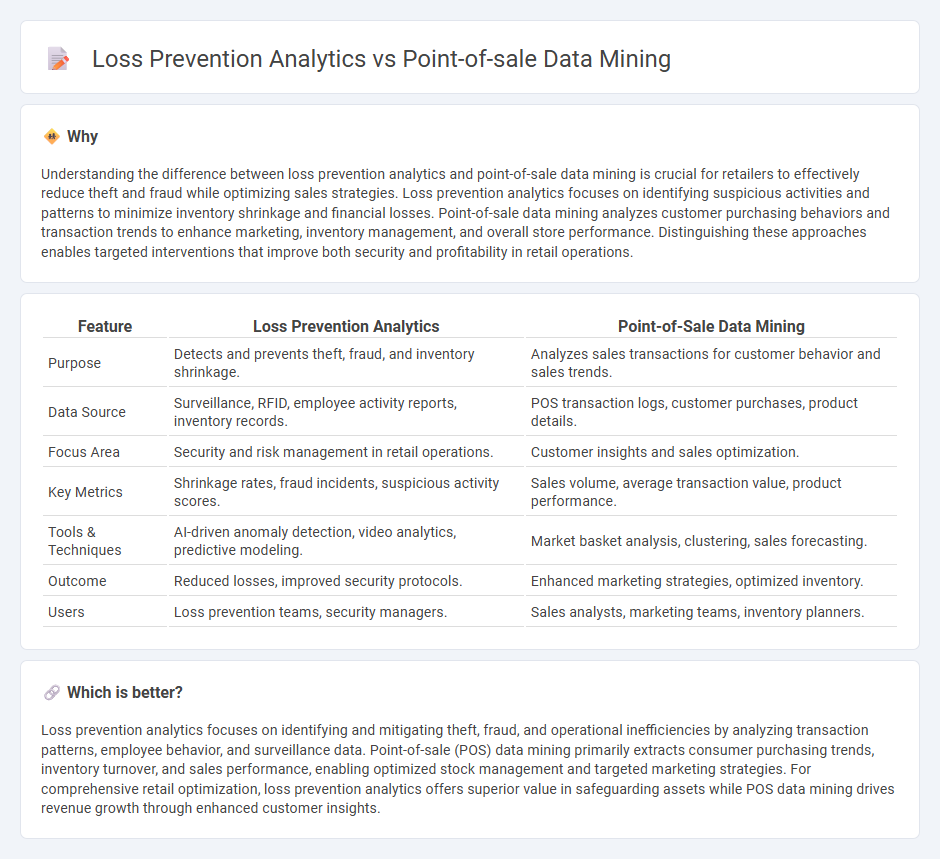
Loss prevention analytics focuses on identifying and mitigating theft, fraud, and operational risks through advanced data analysis techniques, while point-of-sale data mining extracts sales trends, customer behavior, and inventory insights from transaction records. Combining both approaches enhances retail security and optimizes sales strategies by leveraging real-time data and predictive modeling. Explore the benefits of integrating loss prevention analytics with point-of-sale data mining to safeguard your retail operations and boost profitability.
Why it is important
Understanding the difference between loss prevention analytics and point-of-sale data mining is crucial for retailers to effectively reduce theft and fraud while optimizing sales strategies. Loss prevention analytics focuses on identifying suspicious activities and patterns to minimize inventory shrinkage and financial losses. Point-of-sale data mining analyzes customer purchasing behaviors and transaction trends to enhance marketing, inventory management, and overall store performance. Distinguishing these approaches enables targeted interventions that improve both security and profitability in retail operations.
Comparison Table
| Feature | Loss Prevention Analytics | Point-of-Sale Data Mining |
|---|---|---|
| Purpose | Detects and prevents theft, fraud, and inventory shrinkage. | Analyzes sales transactions for customer behavior and sales trends. |
| Data Source | Surveillance, RFID, employee activity reports, inventory records. | POS transaction logs, customer purchases, product details. |
| Focus Area | Security and risk management in retail operations. | Customer insights and sales optimization. |
| Key Metrics | Shrinkage rates, fraud incidents, suspicious activity scores. | Sales volume, average transaction value, product performance. |
| Tools & Techniques | AI-driven anomaly detection, video analytics, predictive modeling. | Market basket analysis, clustering, sales forecasting. |
| Outcome | Reduced losses, improved security protocols. | Enhanced marketing strategies, optimized inventory. |
| Users | Loss prevention teams, security managers. | Sales analysts, marketing teams, inventory planners. |
Which is better?
Loss prevention analytics focuses on identifying and mitigating theft, fraud, and operational inefficiencies by analyzing transaction patterns, employee behavior, and surveillance data. Point-of-sale (POS) data mining primarily extracts consumer purchasing trends, inventory turnover, and sales performance, enabling optimized stock management and targeted marketing strategies. For comprehensive retail optimization, loss prevention analytics offers superior value in safeguarding assets while POS data mining drives revenue growth through enhanced customer insights.
Connection
Loss prevention analytics leverages point-of-sale data mining to identify transaction patterns and detect anomalies indicative of theft, fraud, or cashier errors. By analyzing sales data in real-time, retailers can pinpoint suspicious activities such as voids, refunds, or unusual discounting that may signal internal or external loss risks. Integrating these technologies enhances inventory accuracy, minimizes shrinkage, and supports strategic decision-making to safeguard retail profitability.
Key Terms
**Point-of-sale data mining:**
Point-of-sale data mining involves analyzing transactional data collected at checkout to identify purchasing patterns, optimize inventory management, and enhance customer segmentation. This process leverages machine learning algorithms to detect trends, forecast demand, and improve sales strategies based on real-time sales metrics. Explore how point-of-sale data mining can transform retail operations by driving data-driven decisions and increasing profitability.
Basket Analysis
Point-of-sale data mining leverages transactional data to identify purchasing patterns and customer behavior through Basket Analysis, uncovering item associations and market basket affinities that drive sales strategies. Loss prevention analytics, while also utilizing Basket Analysis, focuses on detecting anomalies and suspicious transaction patterns indicative of potential fraud or theft, enhancing inventory protection. Explore how integrating these analytical approaches maximizes retail performance and security.
Sales Pattern Detection
Point-of-sale data mining uncovers sales pattern detection by analyzing transaction records to identify trends in customer purchasing behavior, peak sales periods, and product performance. Loss prevention analytics centers on detecting anomalies and irregularities in sales data that may indicate theft, fraud, or operational inefficiencies. Explore detailed methodologies and tools to enhance your retail strategy by learning more about these advanced analytical approaches.
Source and External Links
Point-of-Sale Data Analysis AI Agents - Relevance AI - Point-of-Sale data mining involves examining transaction data from retail purchases to gain insights on product sales, customer behavior, inventory management, sales trends, and performance metrics, often enhanced by AI for predictive analytics and automated decision-making.
What is Point of Sale (POS) Data? Uses, Types & Dataset Examples - POS data mining includes analyzing sales frequency, customer demographics, purchase patterns, and inventory status to identify sales trends, customer segments, and reasons for product returns or exchanges.
Understanding POS Data: Unlocking Insights for Your Business - Effective POS data mining combines multiple data sets, defines clear objectives, and applies contextual analysis to generate actionable strategies for marketing, inventory management, and business operations while addressing data volume and quality challenges.
 dowidth.com
dowidth.com